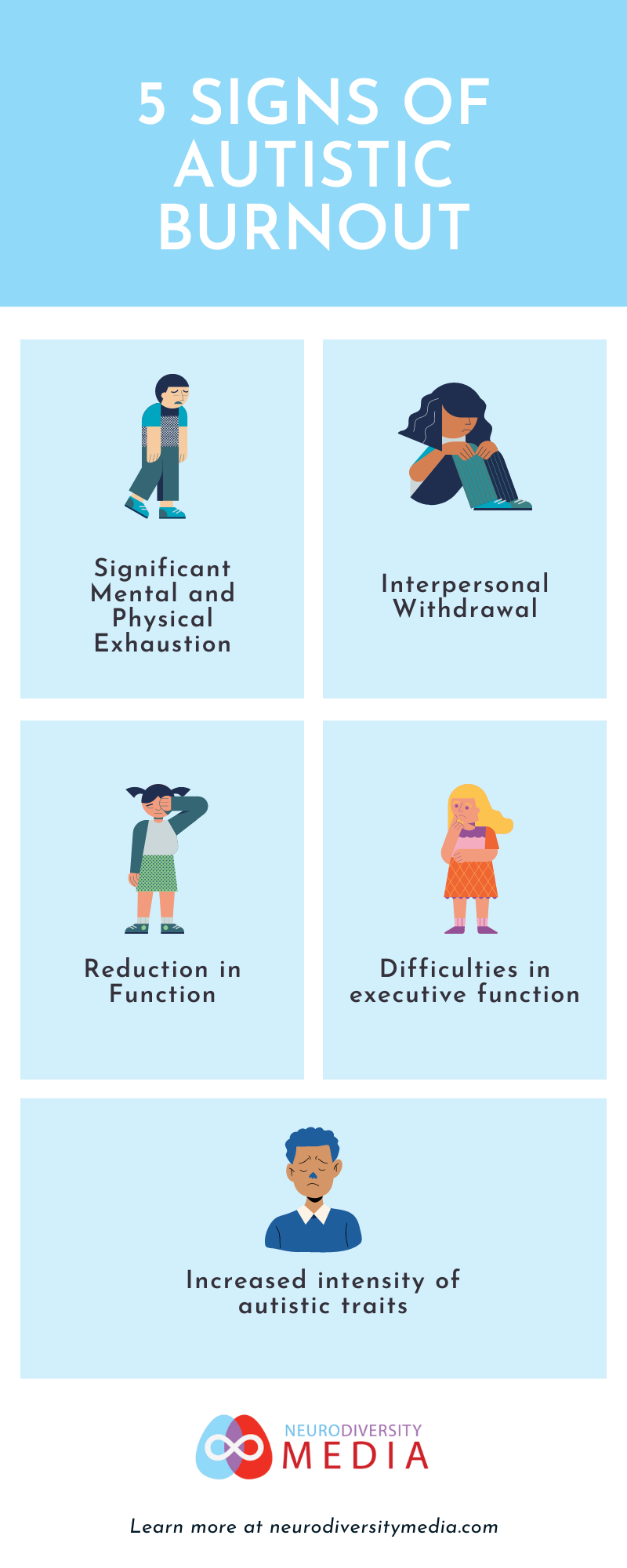Autistic Burnout 101

Autistic Burnout Guide | Part 1 | 3/12/2021
INTRODUCTION: WHAT IS AUTISTIC BURNOUT?
Understanding the characteristics of autistic burnout enables both autistic individuals pursuing or preparing to embark on careers, as well as management within organisations, to cultivate workplace optimisation and embed inclusivity. While autistic burnout does overlap with elements of everyday burnout, it is distinguished by specific features. According to researchers, the most basic criteria must be met:
- Significant mental and physical exhaustion
- Interpersonal withdrawal
Furthermore, one or more of the following criteria must also be met:
- Significant reduction in social, occupational, educational, academic, behavioural, or other important areas of functioning
- Confusion, difficulties with executive function, and/or dissociative states
- Increased intensity of autistic traits and/or reduced capacity to camouflage/mask e.g. increased sensory sensitivity, repetitive or stimming behaviour, difficulty engaging or communication with others

Other researchers in 2018 have also defined autistic burnout as “a syndrome conceptualised as resulting from chronic life stress and a mismatch of expectations and abilities without adequate support”.They note that autistic burnout is also characterised by:
- Pervasive, long-term exhaustion (typically 3+ months)
- Loss of function
- Reduced tolerance to stimulus
Exhaustion: For autistic people, chronic exhaustion is the symptom of being left with no energy simply by the routine of daily life. As one autistic participant puts it: “The brutal truth is that for an autistic person, simply existing in the world is knackering -- never mind trying to hold down a job or having any sort of social life.”
Loss of function: For some autistic people, depending on the severity of their burnout, executive functioning skills may be severely impacted or never return to full function. Even the act of talking can be too much, causing many to resort to non-verbal communication.
Reduced tolerance to stimulus: Many autistic people can be extra sensitive to stimuli such as noises. Autistic burnout may exacerbate this sensitivity. Bright lights and noises create increased instances of meltdowns and shutdowns, driving autistic people to isolate themselves to relieve the burden on their senses.
Life stress: The biggest life stress faced by most autistic people is through the act of masking, which means the suppression of traits like stimming (hand-flapping) or avoiding eye contact in an effort to fit in with the broader world.
Barriers to Support: Gaslighting, a term often mentioned in the context of domestic violence, is also used in the context of autistic people who are told that their troubles are their own fault or whose difficulties are dismissed as something that happens to everyone. Many autistic people also struggle to set boundaries, such as not understanding how to say “no” to requests or expectations, how to negotiate their own limits or how to self-advocate.
Expectations Outweigh Abilities: The tipping point for autistic burnout may arrive when the load on autistic people becomes more than they can manage with existing resources. They also may struggle to replenish resources or access support. To quote another simile raised by a participant: “Don’t expect us to keep operating at above-peak level. We’re like a light sedan car that’s driven like a semi-diesel hauler. We burn out when over-done.”
For more information about the signs and symptoms of autistic burnout, visit this webpage here.
HOW OFTEN DOES AUTISTIC BURNOUT OCCUR?
Researchers have suggested that autistic burnout can occur in "numerous burnout episodes, with onset usually in adolescence, and a recurring cycle that interfered with personal progress and achievement." (Mantzalas et al). Recovery can often take months or even years, leading to lengthy study or career breaks.
WHAT IS NOT AUTISTIC BURNOUT?
Depression: Autistic burnout is usually triggered by social interaction demands and masking fatigue, which require social withdrawal as a recovery strategy, not CBT. Depression is caused by a large variety of life stressors, which usually involve CBT, antidepressants and social activity to mitigate. However, it is important to note that depression and autistic burnout can co-exist.
Standard Burnout (non-autistic): What people refer to “burnout” is in the context of burnout, while autistic burnout is linked specifically to stresses caused by social interaction, camouflaging and unsupportive environments. Any cynicism in “autistic burnout” is usually directed at neurotypical people, not employment.
Autistic Meltdown: Severe, short-term situation that involves overpowering emotions, while burnout is associated with perceived emotional numbness.
LIVED EXPERIENCES: ACCOUNTS OF AUTISTIC BURNOUT FROM THE RESEARCH
"In burnout and going on Month 15. No end in sight. Experienced it maybe 4 times now. I crashed and burned hard."
"A couple of years ago I had a full burnout that could have potentially actually killed me and that left me permanently changed and not for the better."
"I’m #ActuallyAutistic and I view Autism as a mental health issue, but not a mental illness. Lack of accommodation, stigma, & burnout all affect my [mental health]."
"It feels like my thoughts are encased in taffy."
‘‘You need enough balloons to manage the weight of the rocks’’
"Autism only gives me so much energy to work with and if I overstretch myself, I’ll be prone to meltdown and burnout."
"Burnout was huge. 39 months later and my life is very different but much more sustainable."
"I need to get back into my #actuallyautistic skin and stop letting others separate me from my #autistic self. I died to get here. I must always remember that."
Get the latest news on autistic burnout by signing up for the fortnightly NeuroWork Newsletter today:
BIBLIOGRAPHY
Higgins et al, ‘Defining autistic burnout through experts by lived experience: Grounded Delphi method investigating’ #AutBurnout (https://journals.sagepub.com/doi/abs/10.1177/13623613211019858)
Raymaker et al, 'Having All of Your Internal Resources Exhausted Beyond Measure and Being Left with No Clean-Up Crew”: Defining Autistic Burnout' (https://www.liebertpub.com/doi/10.1089/aut.2019.0079#:~:text=“Autistic%20burnout”%20is%20often%20used,in%20every%20area%20of%20life.&text=Informally%2C%20autistic%20adults%20describe%20how,pushed%20them%20to%20suicidal%20behavior)
Jane Mantzalas et al, 'What is Autistic Burnout? A Thematic Analysis of Posts on Two Online Platforms' (https://www.researchgate.net/profile/Jane-Mantzalas/publication/354747628_What_Is_Autistic_Burnout_A_Thematic_Analysis_of_Posts_on_Two_Online_Platforms/links/614ea273154b3227a8a8be26/What-Is-Autistic-Burnout-A-Thematic-Analysis-of-Posts-on-Two-Online-Platforms.pdf)